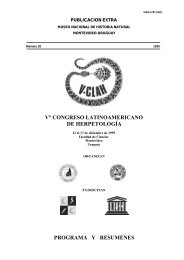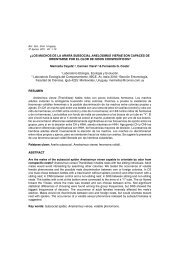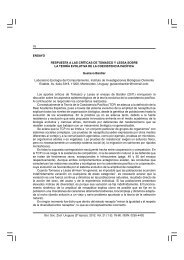Primer Congreso Uruguayo de Zoología - Sociedad Zoológica del ...
Primer Congreso Uruguayo de Zoología - Sociedad Zoológica del ...
Primer Congreso Uruguayo de Zoología - Sociedad Zoológica del ...
You also want an ePaper? Increase the reach of your titles
YUMPU automatically turns print PDFs into web optimized ePapers that Google loves.
AN ENIGMATIC PAMPATHERIIDAE (MAMMALIA, CINGULATA) FROM THE EARLYMIOCENE OF URUGUAYBostelmann E. 1 , Rin<strong>de</strong>rknecht A. 1 , Perea D. 2 & Carlini A.A. 31 Museo Nacional <strong>de</strong> Historia Natural. Montevi<strong>de</strong>o, Uruguay. 2 Departamento <strong>de</strong> Evolución <strong>de</strong> Cuencas, Facultad <strong>de</strong> Ciencias. Montevi<strong>de</strong>o,Uruguay. 3 CONICET; Departamento <strong>de</strong> Paleontología <strong>de</strong> Vertebrados, Museo <strong>de</strong> La Plata, B1900. La Plata, Argentina.ebostel@yahoo.comPampatheriidae conform an extinct family of cingulates whose ol<strong>de</strong>st record comes from the middle Miocene (LaventanSALMA) of Colombia. While common during the Pleistocene, the Mio-Pliocene record of the family is scant and largely basedupon incomplete materials. In Uruguay, Miocene Pampatheriidae has been <strong>de</strong>scribed exclusively over isolated osteo<strong>de</strong>rmsassigned to Kraglievichia paranense, or punctual references of the occurrence of Vassallia. In this presentation we <strong>de</strong>scribewell preserved skeletal remains of a quite peculiar Miocene Pampatheriidae. The materials are housed in the MuseoPaleontológico <strong>de</strong>l Real <strong>de</strong> San Carlos (AC) in Colonia. AC 1050 inclu<strong>de</strong>s an almost complete carapace of an adult individualwith the associated skull, several isolated osteo<strong>de</strong>rms, and two vertebrae. The remains were exhumed at the San Pedrolocality in marine facies of the Camacho Formation. Absolute isotope dates over invertebrate valves at this locality producesan 18 Ma (early Miocene) age, making this specimen the ol<strong>de</strong>st known member of the family. The carapace is composed by ascapular buckler with seven preserved bands, three movable bands and a pelvic buckler with at least seven rows of fixedosteo<strong>de</strong>rms. The cranium is embed<strong>de</strong>d in the matrix, exposing only the anterior portion of the palate and the shavedsections of an ellipsoid M4, and the M5 – M7 teeth. The latters are bilobed and lack the typical isthmus that separates theanterior and posterior lobes. The scapular and mobile osteo<strong>de</strong>rms follows the general pattern observed in the family but thepelvic osteo<strong>de</strong>rms exhibits a very unusual morphology. This inclu<strong>de</strong>s very thin sections, flat central figures with tenuoussulcus, and rugouse expan<strong>de</strong>d anterior and lateral bor<strong>de</strong>rs, ma<strong>de</strong>-up by an important number of punctuations, tubers,foramina, and small roun<strong>de</strong>d peripheral figures. The finding of these associated remains becomes an important element forthe current review of the taxonomy of the Pampatheriidae.HISTORY VERSUS ENVIRONMENT ON THE ECOLOGICAL STRUCTURE OF MAMMALIANASSEMBLAGES OF THE COASTAL TEMPERATE RAINFORESTS OF THE AMERICASBostelmann E. 1,2 , Sprechmann P. 3 , Brazeiro A. 4 & Rodríguez J. 51 Museo Nacional <strong>de</strong> Historia Natural. Montevi<strong>de</strong>o, Uruguay. 2 Instituto <strong>de</strong> Ecología y Ciencias Ambientales, IECA. Facultad <strong>de</strong> Ciencias,Universidad <strong>de</strong> la República. Montevi<strong>de</strong>o, Uruguay. 3 Instituto <strong>de</strong> Ciencias Geológicas, Facultad <strong>de</strong> Ciencias. Montevi<strong>de</strong>o, Uruguay. 4Instituto <strong>de</strong> Ecología y Ciencias Ambientales, IECA. Facultad <strong>de</strong> Ciencias, Universidad <strong>de</strong> la República. Montevi<strong>de</strong>o, Uruguay. 5 CentroNacional <strong>de</strong> Estudios <strong>de</strong> la Evolución Humana, CENIEH, Avenida <strong>de</strong> La Paz 28, Burgos, España. ebostel@yahoo.comAmerican Coastal Temperate Rainforests (ACTR) extends along the western pacific slopes of northern United States(Evergreen forests) and south-central Chile (Valdivian Temperate Rainforest). Despite their different evolutionary origins,both ecosystems are characterized by low average temperatures, high rainfall (over 2,000 mm annually) and a cleardominance of the high stratum canopy ma<strong>de</strong> up by perennial ever-green species. The Ecological Convergence hypothesis(EC) predicts that communities un<strong>de</strong>r similar environmental conditions exhibit similar structure, regardless of the i<strong>de</strong>ntityof the species that composed them. In this presentation we evaluate the predictions of EC hypothesis in the ACTR, basedon the comparison of ecomorphological features of the Terrestrial Mammal Species (TMS) that inhabit them. Using ageographic information system with the distribution of each species, we have mapped the common occurrence of TMSaccording to the various types of environment in which they are localized. Each species has been classified into one of 23ecotypes <strong>de</strong>fined by their food habits, body size and three-dimensional use of space. The structural similarity of localassemblages of species was explored using the correspon<strong>de</strong>nce analysis, utilizing all integrated ecomorphologicalvariables. In contrast to EC hypothesis, mammal assemblages of ACTR exhibits low level of convergence at thehemispheric level. The Valdivian Rainforest mammalian fauna is characterized by a less diverse and abundant number ofecotypes compared with temperate forests faunas of the northern hemisphere. The differences inclu<strong>de</strong> mostly largebody size species, and some specialist’s small mammals. We propose that these differences are mainly due to thedifferent biogeographic-evolutionary history of the southern faunas, coupled with more recent historical processes likethe fini-Pleistocene extinction.<strong>Primer</strong> <strong>Congreso</strong> <strong>Uruguayo</strong> <strong>de</strong> <strong>Zoología</strong> 75







